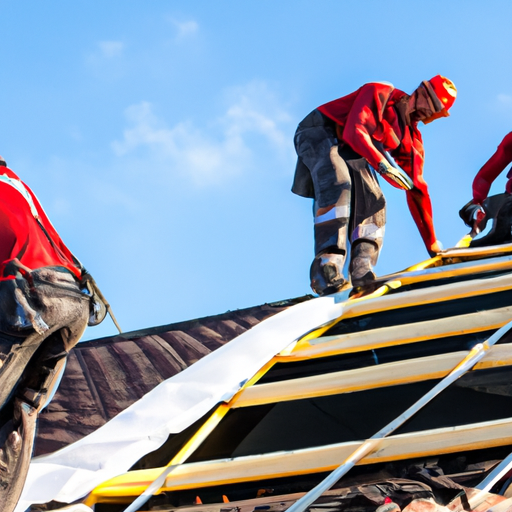Understanding the Key Elements of Roof Construction: An In-Depth Guide
Understanding the key elements of roof construction is crucial for anyone involved in the building or renovation process. A well-designed and properly constructed roof is essential for the overall structural integrity and longevity of a building. In this in-depth guide, we will take a closer look at the primary components that make up a roof and their importance in the construction process.
The first and most fundamental element of roof construction is the roofing materials. There are various options available, including asphalt shingles, metal sheets, clay tiles, and concrete slabs. The choice of roofing material depends on factors such as climate, budget, and aesthetics. Each material has its own unique properties and installation requirements, which should be taken into consideration during the planning stage.
The next crucial component is the roof truss system, which provides support for the entire roof structure. Trusses are pre-fabricated frames made up of beams, posts, and connectors. They are engineered to distribute the weight of the roof evenly and transfer it to the load-bearing walls or columns of the building. The design of the truss system depends on factors such as roof shape, span, and load requirements.
In addition to the truss system, the roof’s sheathing plays a significant role in maintaining its structural integrity. Sheathing is a layer of plywood or oriented strand board (OSB) that is attached to the trusses or rafters. It provides a solid substrate for the roofing materials, distributes the weight of the roof evenly, and helps resist wind uplift. Proper installation of sheathing is essential to prevent sagging, warping, or any other form of structural damage.
Another crucial element to consider is the roof’s insulation. Insulation plays a vital role in maintaining energy efficiency and preventing heat loss or gain through the roof. Common insulation materials used in roof construction include fiberglass, cellulose, and foam. The insulation is usually installed between the trusses or rafters and is covered with a vapor barrier to prevent moisture accumulation.
Ventilation is also an essential aspect of roof construction. A well-ventilated roof helps control the temperature and humidity levels within the building, preventing the formation of condensation and potential damage to the roofing materials. It also contributes to the overall comfort of the occupants and prolongs the lifespan of the roof. Ventilation can be achieved through the use of ridge vents, soffit vents, or gable vents, depending on the design of the roof.
Lastly, the roof flashing and drainage system are crucial components in preventing water infiltration and protecting the building from leaks. Flashing, typically made of metal, is installed around roof protrusions such as chimneys, vents, and skylights to create a watertight seal. A properly designed and installed drainage system, including gutters and downspouts, directs water away from the roof and foundation, preventing water damage and erosion.
In conclusion, understanding the key elements of roof construction is essential for ensuring a well-built and long-lasting roof. By considering factors such as roofing materials, truss systems, sheathing, insulation, ventilation, flashing, and drainage, one can design and construct a roof that provides both functional and aesthetic benefits to the building.
Step-by-Step Guide to Roof Construction: From Design to Installation
When it comes to roof construction, a step-by-step guide is essential to ensure a successful project. From the initial design phase to the actual installation, each step requires careful planning and execution. In this comprehensive guide, we will take you through the entire process of roof construction.
Step 1: Design
The first step in roof construction is the design phase. This is where the blueprint for the roof is created, taking into consideration factors such as the building’s architectural style, climate, and roofing material options. It’s crucial to work with an experienced architect or roofing specialist during this stage to ensure that the design meets the structural requirements and aesthetic goals of the project.
Step 2: Material Selection
After the design is finalized, the next step is choosing the right roofing materials. The options range from asphalt shingles to metal panels, clay or concrete tiles, and even green roofs. Each material has its own advantages and disadvantages, such as durability, cost, and maintenance requirements. It’s important to consider factors like the building’s location, budget, and desired energy efficiency when selecting the roofing materials.
Step 3: Permits and Permissions
Before any construction work can begin, it is crucial to obtain the necessary permits and permissions from local authorities. This step ensures that the roof construction meets all safety and building code requirements. Hiring a licensed contractor familiar with the local regulations can simplify this process, as they will handle the paperwork and ensure compliance with the necessary codes.
Step 4: Preparation and Installation
Once the design is approved, materials are selected, and permits are obtained, it’s time to prepare the site for roof installation. This involves removing the existing roof, inspecting the underlying structure for any damage, and making necessary repairs. Next, the roof deck is installed or repaired, followed by the installation of underlayment, flashing, and any necessary insulation. Finally, the selected roofing material is installed according to the manufacturer’s instructions and industry best practices.
Step 5: Quality Assurance and Maintenance
After the roof is installed, it’s important to conduct a thorough quality assurance inspection. This involves checking for any leaks, loose shingles, or other issues that may compromise the roof’s integrity. Regular maintenance is also essential to extend the lifespan of the roof. This may include cleaning gutters, removing debris, and inspecting for any signs of wear or damage.
In conclusion, a step-by-step guide is crucial for successful roof construction. From the initial design and material selection to the installation and ongoing maintenance, each step plays a vital role in ensuring a durable and efficient roof. By following these steps and working with experienced professionals, you can achieve a well-designed and long-lasting roof for your building.



